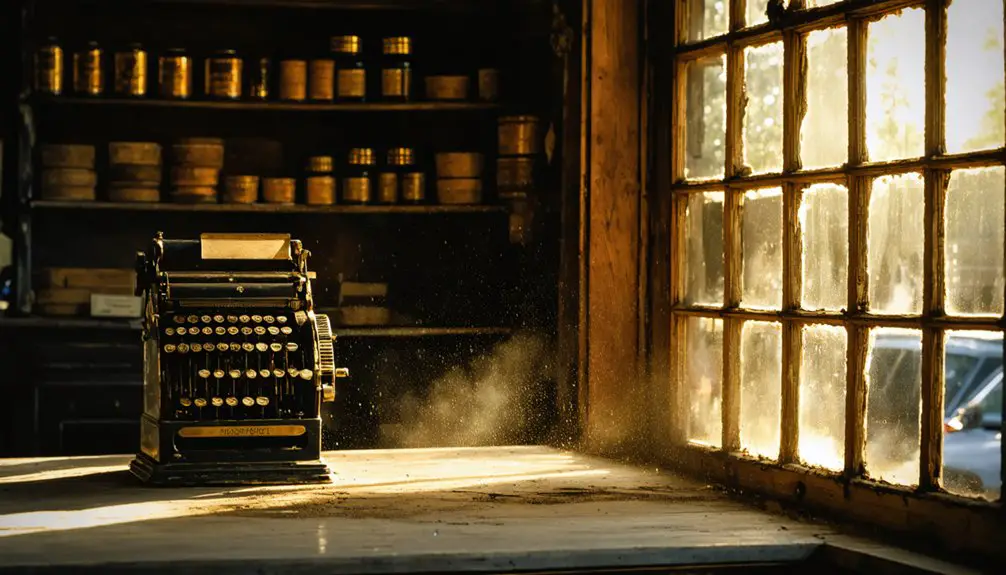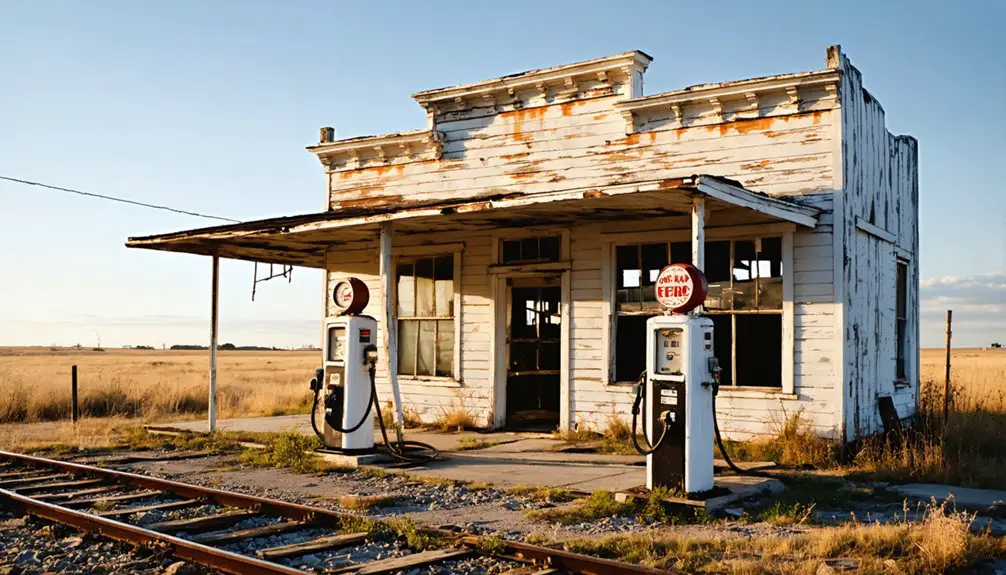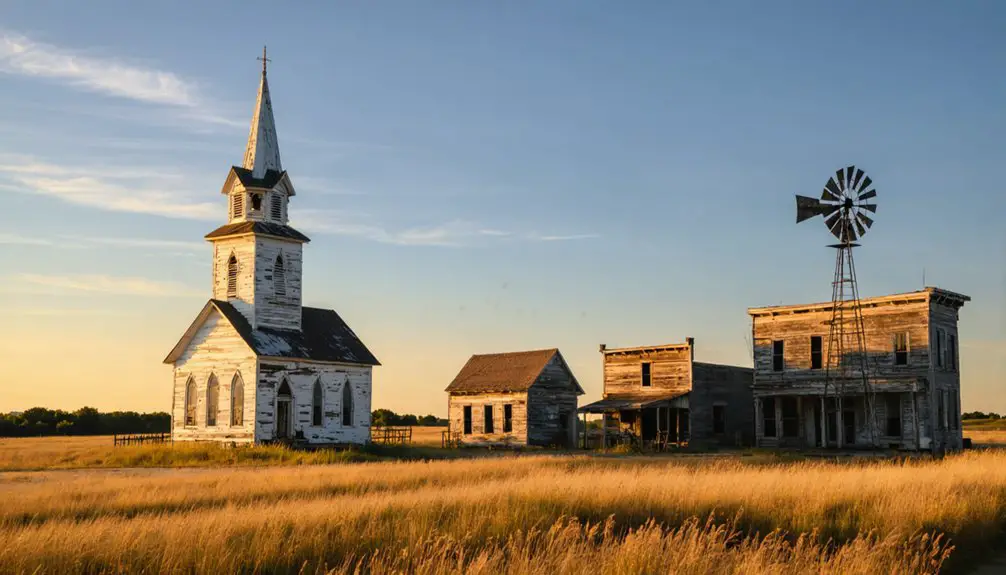You’ll find Amy’s ghost town story begins as a railroad stop in Lane County, Kansas during the late 1800s. Originally named Ellen, it was renamed Amy to avoid postal confusion. The town flourished around its general store, grain elevator, and Baptist church, with baseball games and community gatherings marking its peak years. By 1955, mechanization and urbanization led to its decline. Today, the site lies empty, completely reclaimed by farmland – though its deeper historical impact on Kansas prairie life remains.
Key Takeaways
- Amy, Kansas is now completely empty with no remaining structures, having been entirely reclaimed by agricultural land.
- Originally named Ellen, the town was established as a railway stop in the late 1800s and renamed Amy to avoid postal confusion.
- The town’s decline began with agricultural mechanization and decreased rail service, leading to the general store’s closure in 1955.
- Community life centered around the general store, Baptist church, and school until economic changes forced residents to leave.
- No physical remnants, cemetery, or memorial markers exist today, though county historical societies maintain records of Amy’s past.
Origins and Settlement Era
Although Amy, Kansas began as a railway stop called Ellen in the late 1800s, the U.S. Postal Service requested a name change to avoid confusion with other towns.
Originally known as Ellen, this Kansas railway stop was renamed Amy to prevent postal confusion with similar town names.
You’ll find that Amy’s establishment mirrors the story of many Kansas settlements, where railroads carved paths through untamed prairie and birthed new communities. Much like how Kanona began as Altory in 1881, these towns often underwent name changes during their early development. Similar to Banner’s early years, settlers constructed primitive sod homes as they established themselves in the region. Settlers faced considerable settlement challenges as they built their lives around the railway, constructing sod houses and basic wooden structures in the harsh prairie environment.
The postal influence proved significant in shaping Amy’s identity. Like many frontier towns, Amy depended on its post office as a crucial hub for communication and commerce.
Early pioneers, including immigrants and eastern state residents, staked their claims along the railroad, hoping to build prosperous lives through agriculture, ranching, and railroad-related trade.
Pioneer Life and Community Development
While early settlers faced formidable challenges on the Kansas prairie, they quickly established a vibrant community life in Amy centered around essential institutions.
You’d find pioneer struggles evident in their sod houses and churches, built from prairie materials through collective labor. Yet their communal resilience shone through weekly gatherings at Sunday services, literary clubs, and seasonal celebrations.
The town’s social fabric strengthened around the general store, where you could trade goods and exchange news with neighbors. Like the Free Methodist Church, which was constructed with support from founding resident Cyrus Archer, local baseball games, band performances, and annual picnics brought everyone together, while box dinner fundraisers helped improve shared spaces.
Despite harsh conditions, settlers created a thriving community where recreation and cultural activities flourished around these cherished gathering spots. The Patten Mercantile Co. became a cornerstone of the community through the 1920s, serving as both a trading post and social hub.
Railroad’s Role in Growth
Because the railroad companies sought strategic locations for new stops in Lane County during the late 1800s, Amy emerged as a promising settlement site.
Santa Fe rail line construction in 1887 established Amy’s location and future growth potential.
The town’s growth directly tied to railroad innovations that transformed Kansas’s transportation networks, bringing crucial commerce and cultural connections to the region. Similar to the Scott Special train run of 1905, these rail lines demonstrated the growing importance of high-speed rail transportation across Kansas.
You’ll discover how Amy’s development mirrored other successful railroad towns, with essential services springing up around the tracks.
- A bustling general store served as the community hub, complete with a swing set and baseball field
- Regular train service enabled farmers to ship crops and receive goods efficiently
- The grain elevator became a cornerstone of local agricultural commerce
- Community gatherings and band performances centered around train arrivals
- Business activity thrived until declining rail service led to the store’s closure in 1955
Daily Life and Social Activities
You’ll find that Amy’s social fabric was woven through regular gatherings at the Baptist Church on K-96 and the local school, which served as key community anchors until the school’s closure in 1980.
The town’s social calendar featured musical performances by the uniformed town band at the bandstand, where residents would gather for entertainment and fellowship. Similar to other rural Kansas towns, Amy was originally established as a railroad town, with its social activities centered around the railway station.
Children in the community enjoyed simple pleasures like playing around a small merry-go-round. The general store acted as a daily meeting point where townspeople would exchange news and goods, as evidenced by the store’s counter that’s now preserved in a historical museum.
Community Gatherings and Events
During Amy’s peak years around 1906, the general store emerged as the heart of community life, hosting vibrant social gatherings that drew crowds from across the region.
You’d find the store bustling with activity, especially during Saturday events when horse-drawn wagons and buckboards covered an acre of ground.
These community events centered around the store’s surroundings, where social traditions flourished through various activities.
- Local band performances at the adjacent bandstand, complete with distinctive uniforms
- Baseball games that brought together residents and visitors
- Children’s entertainment on the swing set and merry-go-round
- Weekly gatherings for conversation and commerce at the store’s counter
- Seasonal
Like many small towns affected by deindustrialization in the Midwest, Amy’s vibrant community gatherings gradually declined as local businesses and railways closed. The town’s population steadily decreased until it became one of Kansas’s many abandoned settlements, following a common pattern of ghost town formation.
Church and School Activities
While Amy’s general store served as the town’s commercial hub, the Baptist Church and local schoolhouse formed the spiritual and educational cornerstones of community life.
You’d find the Baptist Church, situated west of Dighton on K96, hosting weddings, funerals, and church gatherings that strengthened local bonds. Community members supported their church through box dinners and fundraisers to maintain essentials like pews and organs.
The one-teacher schoolhouse, which operated until around 1980, wasn’t just for education – it served as a center for school events and cultural activities.
You might’ve found yourself joining other families to listen to the 1935 World Series broadcast on radios brought to school.
After both institutions closed, marking Amy’s decline, their artifacts found preservation in the Lane County Historical Museum.
Economic Rise and Peak Years

While Amy didn’t have a railroad directly through town, the settlement’s strategic location near regional rail lines helped fuel its early economic growth.
You’d find the town’s commercial activity centered around a well-stocked general store and lumberyard, which served farmers and ranchers from the surrounding countryside.
The general store became such a bustling hub of trade by 1906 that wagons and buckboards would fill nearly an acre of ground during busy Saturday markets.
Railroad Brings Economic Prosperity
Throughout the late 1800s, Amy’s strategic position along a major rail line transformed this small Kansas settlement into a thriving economic hub. The railroad expansion brought unprecedented growth, fostering economic diversification through new businesses and services.
You’d have found a bustling community where the general store served as the epicenter of commerce and social life.
- The town raised railroad bonds, demonstrating its commitment to rail-driven progress
- A vibrant general store featured recreational amenities, drawing large Saturday crowds
- Local agriculture flourished with reliable transport for grain and goods
- Businesses like blacksmith shops, boarding houses, and feed mills prospered
- The community’s bandstand and baseball field showcased the town’s economic significance
The railroad’s presence spurred development of essential services including post offices and mercantile companies, making Amy a crucial stop along Kansas’s expanding rail network.
Trading Hub Development
As the turn of the 20th century approached, Amy’s general store emerged as the beating heart of local commerce, transforming this Kansas settlement into a bustling trading hub.
By 1906, you’d find the store grounds alive with trading practices that extended beyond mere business – a swing set, baseball field, merry-go-round, and bandstand created strong community connections.
Saturday crowds would fill nearly an acre of space, arriving by wagons and buckboards to conduct business and socialize.
The Patten brothers later took ownership in the 1920s, establishing the Patten Mercantile Co.
With a population of roughly 100 people, Amy thrived as a regional trading and shipping center, serving agricultural needs and hosting vibrant weekend gatherings that turned the store into an impromptu marketplace and social venue.
Buildings and Infrastructure
Today, only a handful of structures remain standing in Amy, Kansas, including its prominent grain elevator, an old school building, and various agricultural buildings.
You’ll find these structures in varying states of architectural decay, with minimal infrastructure preservation efforts over the decades. The buildings showcase typical rural Kansas construction, featuring wooden frames and simple rectangular designs common to the era.
- The grain elevator stands as the most prominent structure, built with metal and wood for agricultural functionality.
- The old schoolhouse displays a traditional gabled roof design.
- Agricultural outbuildings reflect the town’s farming heritage.
- All remaining structures show significant weathering and deterioration.
- Building foundations and windows have degraded considerably over time.
Factors Leading to Decline

The decline of Amy, Kansas stemmed from multiple interconnected factors that accelerated during the mid-20th century. The town’s economic decline began as agriculture shifted toward large-scale farming operations, reducing the need for local workers and support businesses.
You’ll find this transformation was typical of many Kansas communities, where mechanization decreased employment opportunities and forced younger residents to seek work elsewhere.
Significant demographic shifts followed as families moved away, leaving behind an aging population. The town’s isolation from major transportation routes didn’t help – when railroad services diminished and highway patterns changed, Amy became increasingly disconnected from essential commerce networks.
These challenges, combined with the broader trend of urbanization drawing people to larger cities, created a downward spiral from which the town couldn’t recover.
Notable Residents and Stories
The Patten brothers, Guy and Rodney, shaped Amy’s social fabric through their general store, which served as the town’s primary gathering place in the 1920s.
You’ll find their influence reflected in the store’s amenities, including a bandstand where uniformed community members performed and recreational facilities that drew weekend crowds in wagons and buckboards.
Vance Ehmke’s grandfather’s connection to Patten Mercantile and Amy Bickel’s preservation efforts demonstrate how pioneering families maintained ties to the community even after its decline.
Pioneering Families and Legacies
Among Amy’s most influential residents, store owners Guy and Rodney Patten emerged as central figures during the town’s peak in the 1920s through their operation of Patten Mercantile Co.
These pioneering families helped shape Amy’s identity, establishing a community legacy that’s still remembered today through preserved artifacts at the Lane County Historical Museum.
- The Pattens’ general store served as the town’s primary gathering spot and commercial hub.
- Local farmers like Vance Ehmke maintained connections to Amy’s original business owners.
- Early settlers invested in community amenities including a baseball field and bandstand.
- Residents preserved their history through oral traditions and correspondence.
- The Patten Mercantile Co.’s original fixtures, including the coffee grinder and counter, survive as museum pieces.
Teachers Shape Community Life
While serving as pillars of Amy’s social fabric, teachers extended their influence far beyond classroom walls by organizing literary clubs, leading Sunday services, and coordinating civic activities that strengthened community bonds.
You’ll find that teacher influence permeated every aspect of Amy’s cultural life. They organized baseball games and picnics at the general store’s grounds, fostering community cohesion through recreation.
Their leadership in fundraising efforts supported essential community projects, including church improvements. When the town gathered for Saturday entertainment, you’d see teachers coordinating band performances where musicians proudly wore their uniforms.
The educational community’s impact was so profound that when the general store and other businesses eventually closed, it signaled not just economic decline, but the unraveling of the social fabric teachers had helped weave.
Local Leaders and Characters
Notable residents of Amy left lasting impressions on the town’s identity, with the Patten family standing at the forefront of local commerce and culture.
As community leaders, Guy and Rodney Patten transformed their store into more than just a business – it became the heart of local life.
Today, Vance Ehmke continues to honor Amy’s legacy by preserving historical artifacts, following in his grandfather’s footsteps who maintained strong business ties with Patten Mercantile.
- The Patten brothers operated the town’s central gathering spot through their Patten Mercantile Co.
- Local characters would gather at the store’s bandstand for uniformed musical performances.
- Ehmke’s grandfather exemplified multi-generational business relationships.
- Amy Bickel emerged as a modern champion of the town’s history.
- The store owners fostered community spirit by providing recreational amenities.
Remaining Landmarks Today
Today, virtually no original structures or landmarks remain in the ghost town of Amy, Kansas. The brief existence of its post office (1884-1885) and subsequent relocation to Busby suggests any postal buildings have long since vanished.
Amy, Kansas stands empty today, its brief postal history and vanished structures leaving no trace of the former settlement.
While historical records mention a lumberyard and general store operated by Patten Mercantile Co., you won’t find these structures standing today.
Unlike other Kansas ghost towns that maintain landmark significance through surviving grain elevators, churches, or schools, Amy’s site has been completely reclaimed by agricultural land.
You’ll find no cemetery, memorial markers, or visible foundations typical of ghost town characteristics. The railroad infrastructure that once made Amy an essential stop has disappeared into the rural landscape.
If you’re seeking physical remnants of Amy’s past, you’ll need to consult county historical societies rather than visit the site itself.
Historical Impact on Kansas Prairie Life

Although Amy’s physical presence has vanished from the Kansas landscape, its brief existence exemplifies how railway stops transformed prairie life in the late 1800s. The town’s story reveals how social dynamics and agricultural practices intertwined to shape Kansas communities, offering essential lessons about frontier development.
- You’ll find that railroad access determined whether towns thrived or failed, connecting remote farmers to critical markets.
- Communities built vibrant social lives around general stores, hosting baseball games, band concerts, and picnics.
- Local stores and grain elevators served as economic lifelines, linking prairie farmers to broader markets.
- Town residents worked together to fund shared amenities like church organs, showing strong community bonds.
- The shift to mechanized farming eventually reduced rural populations, leading to the decline of towns like Amy.
Frequently Asked Questions
What Was the Population of Amy During Its Peak Years?
While exact population trends weren’t recorded, you’ll find Amy’s peak years in the early 1900s likely supported between 100-200 residents, based on comparable Kansas towns and local business activity.
Are There Any Ghost Stories or Supernatural Legends About Amy?
You won’t find any haunted locations or local folklore in Amy – even if you check your smartphone’s ghost-hunting apps. Historical records focus on the town’s everyday life rather than supernatural tales.
What Was the Closest Major Town to Amy During Its Existence?
Dighton was your closest major town, serving as Lane County’s seat with crucial historical connections to Amy. Among nearby settlements, it provided essential commerce, rail links, and administrative services during Amy’s existence.
Did Any Famous Outlaws or Historical Figures Ever Visit Amy?
You won’t find any famous visitors or outlaw legends tied to Amy. Despite hopes of discovering exciting historical connections, there’s no documented evidence that any notorious figures ever passed through this small railroad stop.
When Was the Last Business in Amy Officially Closed Down?
You’ll find that Amy’s last business officially closed in 2003 when the grain elevator burned down. Before that, the general store had closed in 1955, leaving the elevator as the final operation.
References
- https://hpj.com/2018/04/23/the-ghosts-of-kanona-kansas/
- https://hpj.com/2018/07/08/a-130-year-old-general-store-and-memories-keep-kansas-ghost-town-of-banner-alive/
- https://legendsofkansas.com/kansas-ghost-town-list/
- https://www.youtube.com/watch?v=ie3zwwHm2Jg
- http://kansasghosttowns.blogspot.com
- https://www2.ljworld.com/news/2015/mar/29/vanished-towns-dot-prairie-kiowa-county/
- https://naramata-blend.com/2016/03/11/summerland-find-and-the-dead-town-of-amy-kansas/
- http://kansasghosttowns.blogspot.com/2013/12/densmore-kansas-dead-town-in-norton.html
- https://archive.org/download/conquestofsouthw00blan/conquestofsouthw00blan.pdf
- https://freepages.rootsweb.com/~gtusa/history/usa/ks.htm



